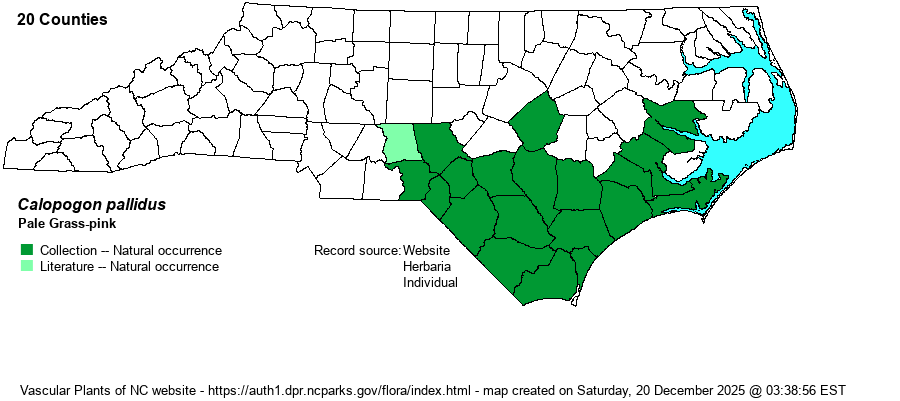| Author | Chapman | |
| Distribution | Present over most of the southern half on the Coastal Plain, to include the Sandhills region. Ranges north to Beaufort, Johnston, Moore, and southeastern Montgomery counties. However, as there are several records for southeastern VA, it may well occur sparingly in the northern half of the Coastal Plain.
This is another Coastal Plain endemic orchid, ranging north to southeastern VA, south to southern FL, and west to eastern LA.
| |
| Abundance | Infrequent to locally fairly common in the lower Coastal Plain, from Croatan National Forest (Craven and Carteret counties) southwest to Brunswick County. Rare to locally uncommon farther inland and northward. As with many species favoring savannas and flatwoods, the species can be quite local or restricted to small sites within these larger regions. | |
| Habitat | This species occurs mostly in pine savannas. It can also occur in sandhill seeps, as well as in the wetter parts of pine flatwoods. It is mostly associated with moist Longleaf Pine (Pinus palustris) habitats. |
| Phenology | Blooms mainly in May and June, rarely into July, not as early as some other Calopogon species. | |
| Identification | Of the four species of Calopogon orchids in the state, this is the easiest to identify. It has pale pink to nearly white flowers, on a stalk of 1-2 feet tall. The relatively few flowers, about 1 inch across, are widely spaced on the stem, and often only one is in bloom at a time. C. tuberosus has the same floral arrangement -- a few widely spaced flowers, often blooming one at a time, but its flowers are larger and are bright pink to often quite rose-colored. All members of the genus have grass-like but "insignificant" leaves on the lower part of the stem. Unlike with C. barbatus and C. multiflorus, this species is numerous enough that you should be able to find it on your own without detailed location information, as long as you can find suitable savannas or wet flatwoods to walk through. | |
| Taxonomic Comments | None
| |
| Other Common Name(s) | None | |
| State Rank | S3 | |
| Global Rank | G4G5 | |
| State Status | | |
| US Status | | |
| USACE-agcp | OBL link |
| USACE-emp | OBL link |

